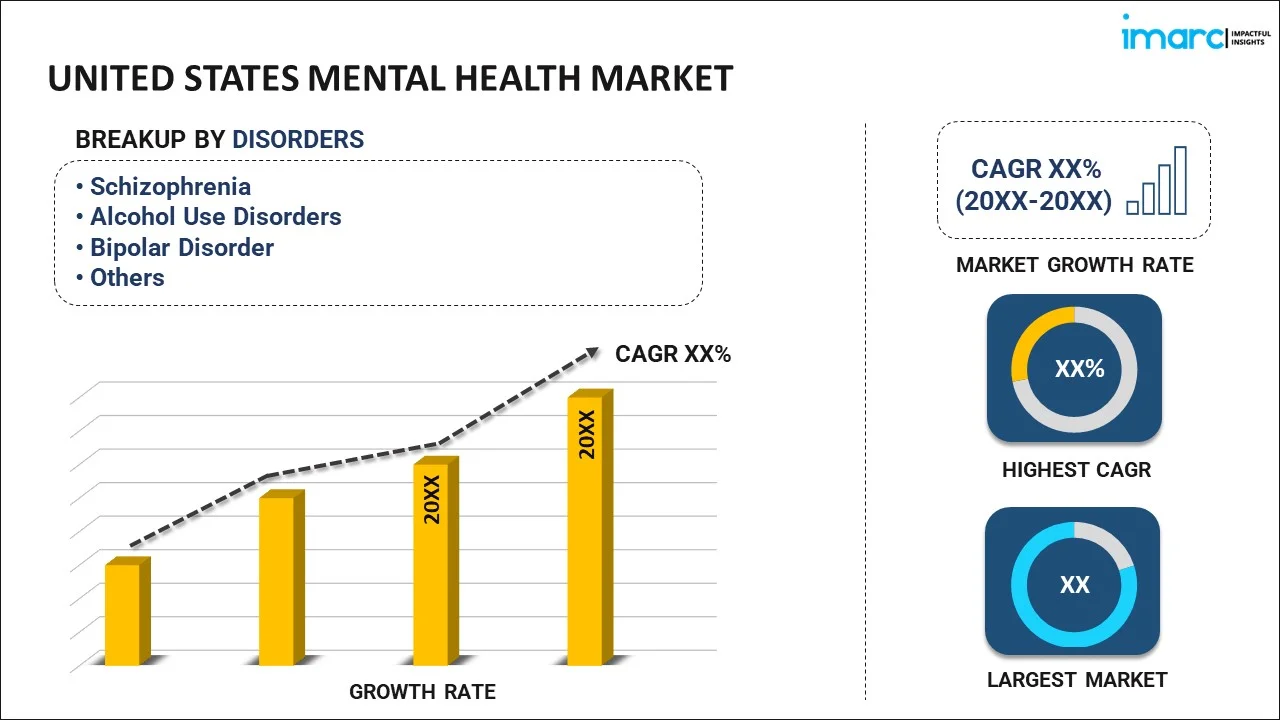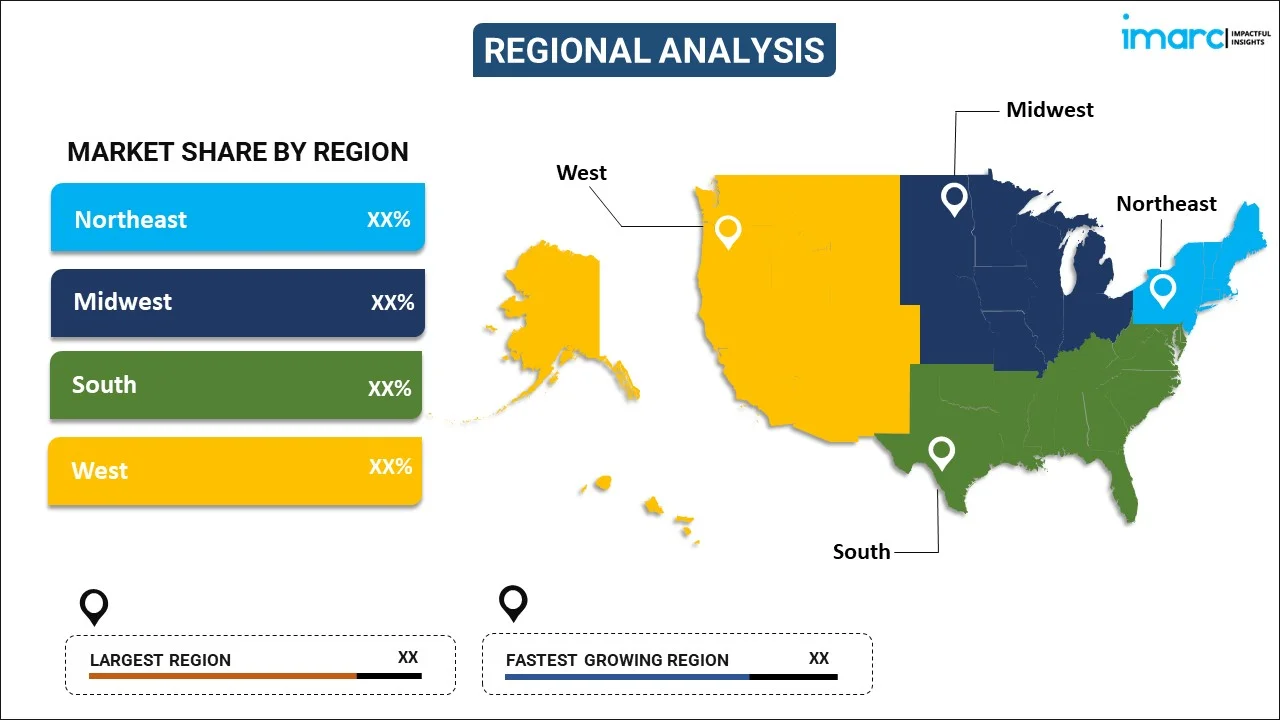IMARC made the whole process easy. Everyone I spoke with via email was polite, easy to deal with, kept their promises regarding delivery timelines and were solutions focused. From my first contact, I was grateful for the professionalism shown by the whole IMARC team. I recommend IMARC to all that need timely, affordable information and advice. My experience with IMARC was excellent and I can not fault it.
Read More
United States Mental Health Market Report by Disorder (Schizophrenia, Alcohol Use Disorders, Bipolar Disorder, Depression and Anxiety, Post-traumatic Stress Disorder, Substance Abuse Disorders, Eating Disorders, and Others), Service (Emergency Mental Health Services, Outpatient Counselling, Home-based Treatment Services, Inpatient Hospital Treatment Services, and Others), Age Group (Pediatric, Adult, Geriatric), and Region 2024-2032
Market Overview:
The United States mental health market size is projected to exhibit a growth rate (CAGR) of 2.2% during 2024-2032. The rising prevalence of mental health conditions, the increasing integration of mental health in primary care, shortages in mental health professionals, technological advancements, legislative reforms, and insurance coverage, and rising public awareness and conversations surrounding mental health represent some of the key factors driving the market.
|
Report Attribute
|
Key Statistics
|
|---|---|
|
Base Year
|
2023
|
|
Forecast Years
|
2024-2032
|
|
Historical Years
|
2018-2023
|
| Market Growth Rate 2024-2032 | 2.2% |
Mental health refers to the overall psychological and emotional well-being of an individual, encompassing their thoughts, feelings, behaviors, and ability to cope with life's challenges. It is an integral aspect of one's overall health, affecting how individuals perceive themselves, interact with others, and navigate the complexities of daily life. Positive mental health involves experiencing a sense of contentment, resilience, and the capacity to manage stress and adversity effectively. It entails having healthy self-esteem, a balanced emotional state, and the ability to form meaningful relationships. Moreover, mental health encompasses the ability to adapt to change, make sound decisions, and pursue personal goals with a sense of purpose. Conversely, poor mental health can manifest as a range of psychological conditions, including anxiety disorders, depression, bipolar disorder, and schizophrenia. These conditions can impact a person's thoughts, emotions, and behaviors, often leading to disruptions in their daily functioning and overall quality of life. Recognizing the significance of mental health, efforts have been made to raise awareness, reduce stigma, and promote access to mental health services. Psychological well-being is influenced by various factors, including genetic predisposition, life experiences, social support systems, and exposure to stressors.
United States Mental Health Market Trends:
The increasing public awareness and conversations surrounding mental health represents one of the key factors driving the growth of the market across the United States. This further reduces stigma and encourages individuals to seek help which is acting as a major growth-inducing factor. High-profile advocacy campaigns and initiatives are spotlighting the importance of mental well-being, which is driving the demand for mental health services, thus boosting the growth of the market. The United States is witnessing a rise in the prevalence of mental health conditions, such as anxiety, depression, and substance use disorders. In line with this, lifestyle changes, socioeconomic stressors, and traumatic events are contributing to this trend, which is bolstering the need for accessible and effective mental health interventions. The market is also driven by significant technological advancements that are revolutionizing mental health service delivery. Telehealth platforms enable individuals to access therapy and counseling remotely, bridging geographical gaps and enhancing convenience, which is fueling the growth of the market. Proliferating mobile apps and online resources offer self-help tools and coping strategies, which are widening the reach of mental health support, thus driving the growth of the market. The increasing integration of mental health services within primary care settings is gaining traction, thereby propelling the growth of the market. This approach ensures early identification and intervention for mental health concerns, which reduces the stigma associated with seeking specialized mental health care, thus creating a positive outlook for the market across the country.
United States Mental Health Market Segmentation:
IMARC Group provides an analysis of the key trends in each segment of the United States mental health market report, along with forecasts at the country level for 2024-2032. Our report has categorized the market based on disorder, service, and age group.
Disorder Insights:

- Schizophrenia
- Alcohol Use Disorders
- Bipolar Disorder
- Depression and Anxiety
- Post-traumatic Stress Disorder
- Substance Abuse Disorders
- Eating Disorders
- Others
The report has provided a detailed breakup and analysis of the market based on the disorder. This includes schizophrenia, alcohol use disorders, bipolar disorder, depression and anxiety, post-traumatic stress disorder, substance abuse disorders, eating disorders, and others.
Service Insights:
- Emergency Mental Health Services
- Outpatient Counselling
- Home-based Treatment Services
- Inpatient Hospital Treatment Services
- Others
A detailed breakup and analysis of the market based on the service has also been provided in the report. This includes emergency mental health services, outpatient counselling, home-based treatment services, inpatient hospital treatment services, and others.
Age Group Insights:
- Pediatric
- Adult
- Geriatric
A detailed breakup and analysis of the market based on the age group has also been provided in the report. This includes pediatric, adult, and geriatric.
Regional Insights:

- Northeast
- Midwest
- South
- West
The report has also provided a comprehensive analysis of all the major regional markets, which include the Northeast, Midwest, South, and West.
Competitive Landscape:
The report has also provided a comprehensive analysis of the competitive landscape in the United States mental health market. Competitive analysis such as market structure, key player positioning, top winning strategies, competitive dashboard, and company evaluation quadrant has been covered in the report. Also, detailed profiles of all major companies have been provided.
United States Mental Health Market Report Coverage:
| Report Features | Details |
|---|---|
| Base Year of the Analysis | 2023 |
| Historical Period | 2018-2023 |
| Forecast Period | 2024-2032 |
| Units | US$ Billion |
| Scope of the Report | Exploration of Historical and Forecast Trends, Industry Catalysts and Challenges, Segment-Wise Historical and Predictive Market Assessment:
|
| Disorders Covered | Schizophrenia, Alcohol Use Disorders, Bipolar Disorder, Depression and Anxiety, Post-Traumatic Stress Disorder, Substance Abuse Disorders, Eating Disorders, Others |
| Services Covered | Emergency Mental Health Services, Outpatient Counselling, Home-Based Treatment Services, Inpatient Hospital Treatment Services, Others |
| Age Groups Covered | Pediatric, Adult, Geriatric |
| Regions Covered | Northeast, Midwest, South, West |
| Customization Scope | 10% Free Customization |
| Report Price and Purchase Option | Single User License: US$ 3699 Five User License: US$ 4699 Corporate License: US$ 5699 |
| Post-Sale Analyst Support | 10-12 Weeks |
| Delivery Format | PDF and Excel through Email (We can also provide the editable version of the report in PPT/Word format on special request) |
Key Questions Answered in This Report:
- How has the United States mental health market performed so far and how will it perform in the coming years?
- What has been the impact of COVID-19 on the United States mental health market?
- What is the breakup of the United States mental health market on the basis of disorder?
- What is the breakup of the United States mental health market on the basis of the service?
- What is the breakup of the United States mental health market on the basis of age group?
- What are the various stages in the value chain of the United States mental health market?
- What are the key driving factors and challenges in the United States mental health market?
- What is the structure of the United States mental health market and who are the key players?
- What is the degree of competition in the United States mental health market?
Key Benefits for Stakeholders:
- IMARC’s report offers a comprehensive quantitative analysis of various market segments, historical and current market trends, market forecasts, and dynamics of the United States mental health market from 2018-2032.
- The research study provides the latest information on the market drivers, challenges, and opportunities in the United States mental health market.
- Porter's five forces analysis assist stakeholders in assessing the impact of new entrants, competitive rivalry, supplier power, buyer power, and the threat of substitution. It helps stakeholders to analyze the level of competition within the United States mental health industry and its attractiveness.
- Competitive landscape allows stakeholders to understand their competitive environment and provides an insight into the current positions of key players in the market.
Need more help?
- Speak to our experienced analysts for insights on the current market scenarios.
- Include additional segments and countries to customize the report as per your requirement.
- Gain an unparalleled competitive advantage in your domain by understanding how to utilize the report and positively impacting your operations and revenue.
- For further assistance, please connect with our analysts.

Purchase Options
Benefits of Customization
Personalize this research
Triangulate with your data
Get data as per your format and definition
Gain a deeper dive into a specific application, geography, customer, or competitor
Any level of personalization
Get in Touch With Us
UNITED STATES
Phone: +1-631-791-1145
INDIA
Phone: +91-120-433-0800
UNITED KINGDOM
Phone: +44-753-714-6104
Email: sales@imarcgroup.com
 Inquire Before Buying
Inquire Before Buying Speak to an Analyst
Speak to an Analyst  Request Brochure
Request Brochure  Request Customization
Request Customization



.webp)




.webp)












